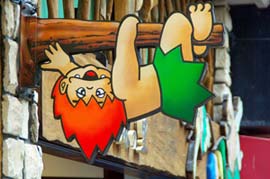
Kijimuna: a mythological character popular in Okinawan folklore. Normally the little trouble-maker is found where there are trees nearby. This one is hanging on a branch on the front of a tourist trap in the capitol city, Naha.
In March of 2009 I had my first article appear in Apogee Photo Magazine. I have now been fortunate enough to contribute to dozens of online publications around the globe and I would like to share with aspiring photojournalists some of the lessons I’ve learned along the way.
It took me awhile to figure that out that Editors are people too. I know some of them can seem demanding, but I’ve figured out that they’re busy folks with deadlines to meet, articles to juggle and under more stress than us freelance writers could ever conjure up in our dreams.
For some reason, I used to picture editors eating their offspring just so they have more room at the kitchen table. Hey, they’re actually humans–just some of them have their antennas tuned into a different frequency, so we writers need to learn to try to get in tune with them.
And if you get the dreaded rejection letter from an Editor, don’t let that discourage you. Be thankful that they took the time to write back and tell you what you’re doing wrong—these are great learning opportunities. I save every one of them and use them as guidelines for my next submission.
I figured out that you don’t have to like editors; they have to like you!
So let’s go “Lookin’ Back” as I share my Top 10 Photojournalist Tips to Getting Published Online.
Note: By the way, I am a not so humble photojournalist, so for your viewing pleasure I have included images covering an array of subjects–“Lookin’ Forward” to being seen by more new publications!
1. You are a Photojournalist – Make Quality Photos
Learn to compose and take pictures that don’t require Photoshopping. Too many up and coming photographers don’t take the time to learn the basic rules of composition, focus and exposure because they rely on editing, after the fact, to try and correct mistakes. Leave the Photoshopping to the pros and learn to photograph like a pro instead.
Try to critique your photos without emotional attachment. Are they good enough to submit for publication—good enough to share with the world?
These couple of steps will make your work stand out above the others.
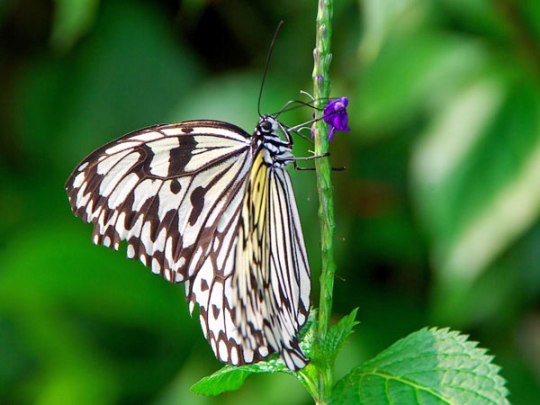
The largest butterfly in Japan, also known as a Rice Paper Butterfly (Idea leuconoe). I think this one was just a pup.
2. Search Online for Potential Markets
Use common sense here. Wedding photography articles are probably not in big demand at wildlife magazines, but a garden wedding column may sell to a gardening magazine. I started off as a Wildlife Photographer and soon discovered I could get a lot more photos and articles published if I was flexible enough to diversify my portfolio, so I got involved in the Travel Writing Business. Now, I’m an Outdoor Photographer & Writer, but I still sneak a wildlife photo in every chance I get!
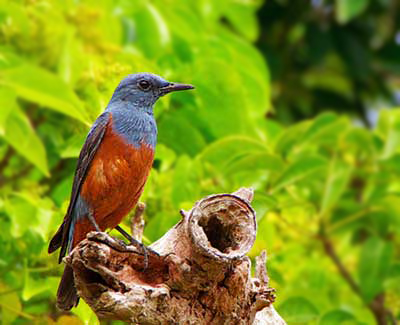
I was born and raised in the United States. The Blue Rock Thrust, Monticola Solarius, is the only bird in Okinawa that reminds me of a Robin.
Note: Published at
Romar Traveler
3. Developing Your Story
There are two ways to write a story:
“Develop” the idea in your mind, write the story and then capture the images to fit the story. “Develop” the photos first and use those photos to create a story.
For me, it’s easier to write an article after I have taken the photos, especially if those photos are taken at a scheduled event.
Look at your photos and write what comes to mind. Use the words you would use in a normal conversation. Don’t try to imitate Mark Twain or Hemmingway–just be natural and enjoy the process. Looking at the photo, sometimes, helps you recall things that were happening while you composed the shot. I can’t remember what I ate yesterday, but I can look at a picture I shot years ago and recall the heat, the wind or the ants crawling up my legs.
Above all else, DO NOT PLAGIARIZE! Develop your own style and write the article in your own words. Quotes are certainly O.K., as long as your state the name of the person whom you’re quoting. Just keep them to a minimum. This is still your article!
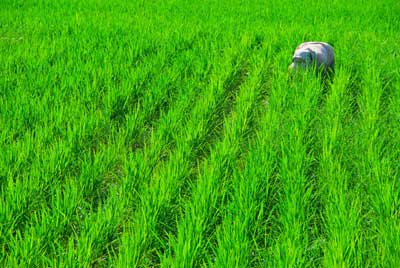
The cost of a bag of rice seems outrageous in Japan, until you learn that, as in this picture, everything is done manually. Photo taken in Yaka, Okinawa.
Note: Published at
The Photo Argus
4. Research Before You Write
When you have something published online it had better be true (some publications will not even publish your work unless the facts are verified). Millions of readers have the opportunity to read your article and see your photos. That’s great–it’s like free advertising. What’s not so great is when someone comes along and calls you a liar. That becomes an embarrassment for both you and the publication.
In my option, online research is one of the most challenging chores with which a writer is faced. There is way too much misinformation floating around on the web for my comfort, so I verify anything I’m not sure of in five or six different places before I stick my neck out and decide something is a fact. Or I’ll write two conflicting facts, giving the source and then let the reader decide.
Always, check your facts and your work will always be on the top of the pile.
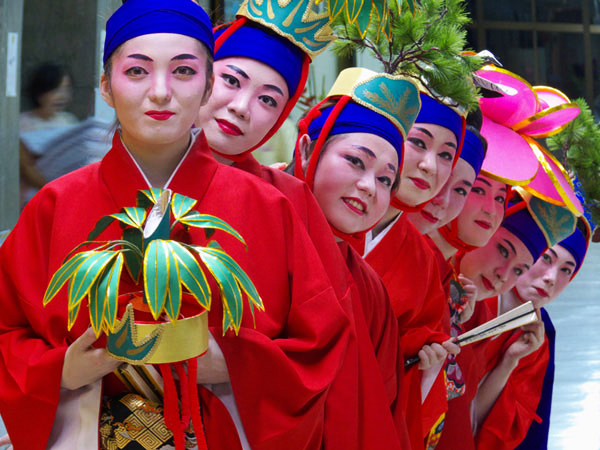
The Young Girl’s Traditional Okinawan Dance Troupe, heavily made-up with really thick “war-paint”, struck a spur-of-the-moment pose for me after their performance. They perform for special occasions (Festivals, etc) in their village and are honored with occasional tours to Hawaii.
5. Your Story Must Be Interesting
Make sure the story flows smoothly with good structure and don’t stray from the subject. You want to maintain the reader’s interest from your first sentence all the way through to the last. Give them a sense of the sights, sounds, smells and feelings you experienced. Make them feel like they are there with you or want to go where you’ve been.
This is the worldwide web, so pay attention to cultural differences, so the readers from around the world will fully understand what you are saying. Since I live in Japan, I have to pay attention to any Japanese words that I use and provide the meaning of those words.
Remember, online, your story is just a click away from being history. On a plane, I may read something boring in a flight magazine just because there’s nothing else to do. Online, nothing gets a chance to bore me–CLICK, they’re gone!

To this little girl, I am Uncle Mike, only because in Okinawa, there’s a saying… “Iichariba chode”, meaning “We have met and now you are family”. This photo was taken at a festival. I promised her father I’d make a good photo for him while she was at the bubble-blowing machine. It was a challenge, but worth all the effort, after all, we’re family!
6. Proof Read Your Text
There are many programs available that will check your spelling and sentence structure. Get one–they make life a lot easier. But, don’t rely entirely on them! I’ve pulled some doozies when my Spell-check was sleeping on the job. It doesn’t know the difference between “years” and “tears”, “goof” and “golf” or an “amateur” photographer from an “armature” photographer! Without proof reading, words can slip right through into your text. It takes a human to see that in the article—to catch words that make no sense (or cents)! Don’t trust a machine unless it’s your camera.
Read what you wrote out loud and then if possible, have at least 2 other people read it. Did your story hold their attention? Was there any emotional reaction to the story, such as laughter? Did it bring forth a memory or engage their senses? Make adjustments accordingly and then read it over again before sending it to an editor.
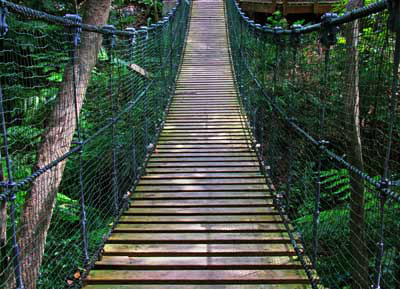
A Bridge to Nowhere:
A wooden suspension bridge was found along a mountain trail in Okinawa while I was out hiking around–my camera is always with me.
7. Pay Attention to Details
Look closely at any site to which you plan on submitting and pay attention to their style and format.
Make sure you are not doing an article on a topic that was just published recently, unless you have a totally different angle.
On your first submission or request, be sure to supply links to your images and any previously written articles so they can then see the quality of your photos and written work.
Each publication has their Writer’s Guidelines or Submission Requirements and it’s your responsibility to make sure they’re followed, not someone else’s. You may have to meet these requirements before an editor will even look at your submission. If you don’t see them on the web site, be sure to ask for the details.
Make choosing your photos an easy task for the editors. There are many sites available on the web where you can display and organize your photos into groups. And sometimes, I’ll display a group of pictures and just send an editor a query with a story idea before ever writing the article. That makes things easier for everyone. Easy is good!
And do whatever you can to make the editor’s job easier. It could be typing in the html codes for your links or putting them in parentheses—again, just ask.
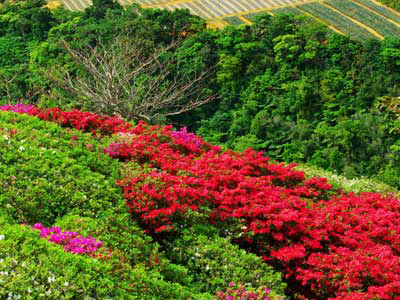
This photo was made in the northern mountains of Okinawa, Japan during the Azalea Festival, not only gives you a glimpse at the rolling landscape of these mountains, but allows you to join in with nature’s way of making them come alive through the bursts of color.
8. Work with the Editors
Once you have struck a deal with a magazine editor you are now part of a team. They may want to change something, either in your writing or with your photos. Be cooperative.
They know how to present your photos in the “best light. I let editors crop, resize, adjust exposure and color on my photos; whatever it takes to make the best presentation for all concerned.
We discuss the text and come up with the final printed product. I figure editors know a heck of a lot more about writing than I ever will. That’s why they’re editors.
Make sure you know the publisher’s deadlines and get your work turned in early, not at the last minute. Editors know the writers on which they can rely and forget about those with whom they are uncertain.

Ryukyu Flying Fox (Bat): These bats eat the fruits of various plant species with figs being their favorite.
The editor cropped this photo horizontally to fit the space, while keeping your eyes drawn to the bat’s eyes.
The Ryukyu flying fox eats the fruits of a variety of plant species. Figs are a favorite.
Read more: http://www.animalinfo.org/species/bat/pterdasy.htm#ixzz0oZet8A9L
The Ryukyu flying fox eats the fruits of a variety of plant species. Figs are a favorite.
Read more: http://www.animalinfo.org/species/bat/pterdasy.htm#ixzz0oZet8A9L
The Ryukyu flying fox eats the fruits of a variety of plant species. Figs are a favorite.
Read more: http://www.animalinfo.org/species/bat/pterdasy.htm#ixzz0oZet8A9L
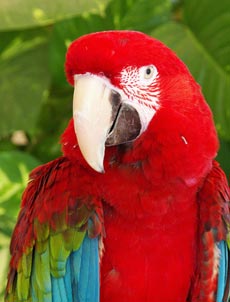
This handsome Parrot
posed quite nicely for me.
Note: Bat photo published on
Matador Travel Network
9. Oops! Know Everybody Can Make a Mistake
Sometimes I’ve caught errors after my article has been submitted, but prior to publication. I’ll have looked it over again a day or two later and caught a mistake or two, but had time to catch the editor before it hit print.
Then, there’s the times an editor had a computer hiccup and misspelled something in the editing process. A misspelling actually gets published. If you don’t tell them, you’re not doing them any favor. They can usually make corrections online and will thank you for your support. Next thing you know, you trust them and they trust you.
10. When Your Work Goes Live
The first thing you’ll want to do is celebrate. It’s a great feeling to see your pictures, your story and your name featured as the Photographer and Writer on some fancy website. You want to email a link to family, friends and maybe even that teacher who said you’d never amount to anything worthwhile.
Copy and paste links into every social network site you can, brag about it, you’ve done well.
You can start thinking of the next assignment and building yourself a resume. NOW, you are a Photojournalist!
And promote not only your work, but the homepage of the magazine and other writers’ work–everybody comes out ahead.
Wait! I forgot something. You’ve become part of a team. You haven’t succeeded by yourself. Go back and thank your editor!
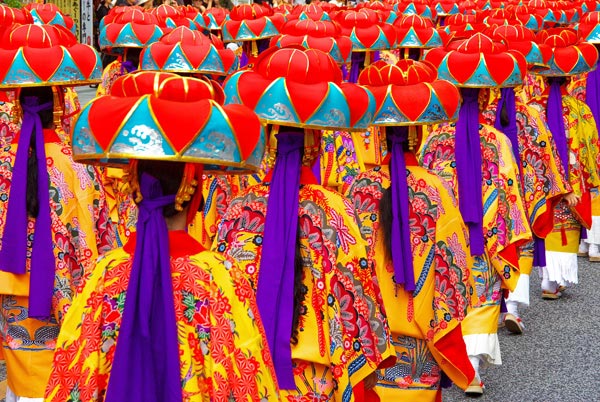
Okinawa Street Dancers during a parade.
Note: Published at In The Know Traveler
Have I learned a lot? You bet! And I’m always looking forward to learning more and being published in new web site locations, lots of them.
So, what’s the big deal about “Lookin’ Back”? I’ll answer that with this question…
How many times has something sneaked up in front of you and bit your rear end?
Photo Posting Tip:
Any web site where your images are posted opens the doors to those with the morals of a fox entering a chicken coop! It’s no different than people stealing free music, videos and movies off the internet. It’s a fact of life! You’re an artist and people will steal your work. Be flattered!
So I do what I can to protect my photos. You can lower the resolution, size them small enough so they’re not printable and do whatever else it takes to protect your photos but, they still get stolen–I know! I also install digital, invisible watermarks in all my photos before posting them online and that is followed by my capability of tracking them anywhere on the web. I find them everywhere. When a millionaire winds up with one in his possession, I’ll be a millionaire, too!
by Michael Lynch
Article and photos: © 2010 Michael Lynch. All right reserved.

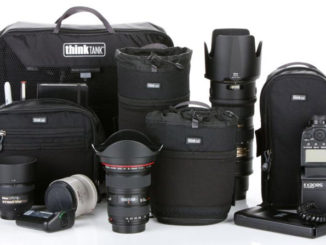
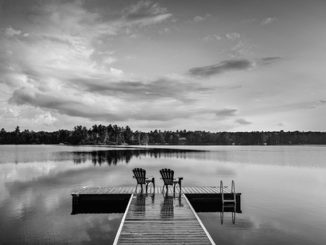
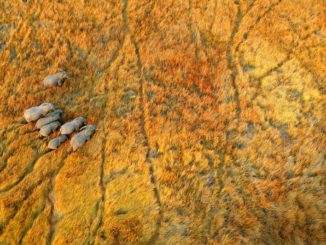
Leave a Reply